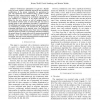Free Online Productivity Tools
i2Speak
i2Symbol
i2OCR
iTex2Img
iWeb2Print
iWeb2Shot
i2Type
iPdf2Split
iPdf2Merge
i2Bopomofo
i2Arabic
i2Style
i2Image
i2PDF
iLatex2Rtf
Sci2ools
CEC
2008
IEEE
2008
IEEE
Evolutionary optimization of a bipedal gait in a physical robot
— Evolutionary optimization of a gait for a bipedal robot has been studied, combining structural and parametric modifications of the system responsible for generating the gait. The experiment was conducted using a small 17 DOF humanoid robot, whose actuators consist of 17 servo motors. In the approach presented here, individuals representing a gait consisted of a sequence of set angles (referred to as states) for the servo motors, as well as ramping times for the transition between states. A hand-coded gait was used as starting point for the optimization procedure: A population of 30 individuals was formed, using the hand-coded gait as a seed. An evolutionary procedure was executed for 30 generations, evaluating individuals on the physical robot. New individuals were generated using mutation only. There were two different mutation operators, namely (1) parametric mutations modifying the actual values of a given state, and (2) structural mutations inserting a new state between two co...
| Added | 29 May 2010 |
| Updated | 29 May 2010 |
| Type | Conference |
| Year | 2008 |
| Where | CEC |
| Authors | Krister Wolff, David Sandberg, Mattias Wahde |
Comments (0)

